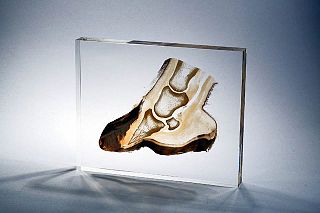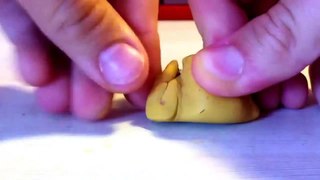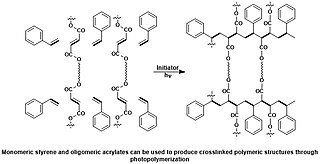
Acrylic embedment is a process of encapsulating various objects into lucite (cast acrylic). The process is used for preserving specimens, encapsulating electronics, and making decorative items such as trophies (deal toys) and jewelry.

Acrylic embedment is a process of encapsulating various objects into lucite (cast acrylic). The process is used for preserving specimens, encapsulating electronics, and making decorative items such as trophies (deal toys) and jewelry.
In the early 1940s, Armand G. Winfield was interested in preserving biological and geological specimens. He developed a method for embedding such specimens in clear acrylic plastic, and by 1945, his process was used to mass-produce objects embedded in acrylic. In addition to preserving specimens, Winfield’s work included encapsulating electronics in acrylic and the production of acrylic jewelry. [1] [2] [3]
The process starts with two basic ingredients, an acrylic resin powder polymer and clear liquid monomer. The polymer and monomer are mixed together in specific proportions. The result is a thick, opaque liquid. The mixture is hand poured into molds and allowed to partially harden. Objects to be embedded are then hand placed into the acrylic layer. Another layer is poured over the embedded object and the acrylic is again allowed to harden.
During this stage, the liquid acrylic is an opaque, milky white. It is very difficult to center objects on multiple levels when the objects below cannot be clearly seen. Because these embedded objects are placed by hand, no two acrylic embedments are ever exactly alike.
After the acrylic has hardened, the molds are placed into an oven. There, heat cures and pressure (exceeding 12 atmospheres) compresses the air bubbles to completely harden the embedment. This curing process may take up to seven hours. After cooling, the acrylic embedments are removed from the molds and the sizing process begins. All acrylic parts are cast oversized to allow for shrinkage, which varies from part to part. Three steps are taken to size the embedments.
The parts are ground down to size by hand on large industrial sanders. A coarse grit belt is used first, followed by a medium grit belt. A final sanding with a fine grit belt makes it easier to polish the sanded acrylic. Variations occur in this sizing process since it is all done by hand.
Polishing is the next step in the process. It is mostly done by hand. This brings out the luster and high gloss of the acrylic not previously seen during production. A rough buffing is administered to remove all sanding lines. A final polishing then brings out the bright crystal-like finish. The production of the acrylic embedment is completed.
The final phase now begins. Each embedment is carefully hand wiped and visually inspected. If flaws or any other defects are detected, the part is returned for additional finishing or rejected for recycling. After passing through inspection, each part is individually bagged and boxed. This entire procedure makes the result more expensive but because of its glossy look an acrylic embedment is very much in demand.
Because of the high amount of technical knowledge required, the total number of manufacturers remains small. These include:
Engraving, Awards & Gifts, Electron Microscopy Sciences, and USAcrylic Awards.
More information can be found here: Engravers Journal and USAcrylic Awards..

Paint is a liquid pigment that, after applied to a solid material and allowed to dry, adds a film-like layer. As art, this is used to create an image, known as a painting. Paint can be made in many colors and types. Most paints are either oil-based or water-based, and each has distinct characteristics.

Poly(methyl methacrylate) (PMMA) is the synthetic polymer derived from methyl methacrylate. It is used as an engineering plastic, and it is a transparent thermoplastic. PMMA is also known as acrylic, acrylic glass, as well as by the trade names and brands Crylux, Hesalite, Plexiglas, Acrylite, Lucite, and Perspex, among several others. This plastic is often used in sheet form as a lightweight or shatter-resistant alternative to glass. It can also be used as a casting resin, in inks and coatings, and for many other purposes.

A thermoplastic, or thermosoftening plastic, is any plastic polymer material that becomes pliable or moldable at a certain elevated temperature and solidifies upon cooling.

Epoxy is the family of basic components or cured end products of epoxy resins. Epoxy resins, also known as polyepoxides, are a class of reactive prepolymers and polymers which contain epoxide groups. The epoxide functional group is also collectively called epoxy. The IUPAC name for an epoxide group is an oxirane.
Catalin is a brand name for a thermosetting polymer developed and trademarked in 1927 by the American Catalin Corporation of New York City, when the patent on Bakelite expired that year. A phenol formaldehyde resin, it can be worked with files, grinders, and cutters, and polished to a fine sheen.

In materials science, a thermosetting polymer, often called a thermoset, is a polymer that is obtained by irreversibly hardening ("curing") a soft solid or viscous liquid prepolymer (resin). Curing is induced by heat or suitable radiation and may be promoted by high pressure or mixing with a catalyst. Heat is not necessarily applied externally, and is often generated by the reaction of the resin with a curing agent. Curing results in chemical reactions that create extensive cross-linking between polymer chains to produce an infusible and insoluble polymer network.

Plastination is a technique or process used in anatomy to preserve bodies or body parts, first developed by Gunther von Hagens in 1977. The water and fat are replaced by certain plastics, yielding specimens that can be touched, do not smell or decay, and even retain most properties of the original sample.

A microscope slide is a thin flat piece of glass, typically 75 by 26 mm and about 1 mm thick, used to hold objects for examination under a microscope. Typically the object is mounted (secured) on the slide, and then both are inserted together in the microscope for viewing. This arrangement allows several slide-mounted objects to be quickly inserted and removed from the microscope, labeled, transported, and stored in appropriate slide cases or folders etc.

Fimo is a brand of polymer clay made by German company Staedtler. Fimo is sold worldwide. Its main U.S. competitor is the American brand Sculpey. The material comes in many different colors; there are many finishes to choose from, and even a softener to use with it because it can be hard to work. It is used for making many objects, including jewelry, accessories, and small ornaments. Once shaped, Fimo is baked in a standard or toaster oven for about 30 minutes at 130 °C (265 °F) to harden it. Once baked, it can be cut, drilled, painted, sanded, and sliced thinly. According to information from Staedtler, Fimo contains polyvinyl chloride (PVC), but has not contained any phthalates since 2006.
Spin casting, also known as centrifugal rubber mold casting (CRMC), is a method of utilizing inertia to produce castings from a rubber mold. Typically, a disc-shaped mold is spun along its central axis at a set speed. The casting material, usually molten metal or liquid thermoset plastic, is then poured in through an opening at the top-center of the mold. The filled mold then continues to spin as the metal solidifies.

Powder coating is a type of coating that is applied as a free-flowing, dry powder. Unlike conventional liquid paint, which is delivered via an evaporating solvent, powder coating is typically applied electrostatically and then cured under heat or with ultraviolet light. The powder may be a thermoplastic or a thermoset polymer. It is usually used to create a thick, tough finish that is more durable than conventional paint. Powder coating is mainly used for coating of metal objects, particularly those subject to rough use. Advancements in powder coating technology like UV-curable powder coatings allow for other materials such as plastics, composites, carbon fiber, and MDF to be powder coated, as little heat or oven dwell time is required to process them.

An acrylate polymer is any of a group of polymers prepared from acrylate monomers. These plastics are noted for their transparency, resistance to breakage, and elasticity.

A photopolymer or light-activated resin is a polymer that changes its properties when exposed to light, often in the ultraviolet or visible region of the electromagnetic spectrum. These changes are often manifested structurally, for example hardening of the material occurs as a result of cross-linking when exposed to light. An example is shown below depicting a mixture of monomers, oligomers, and photoinitiators that conform into a hardened polymeric material through a process called curing.
Synthetic resins are industrially produced resins, typically viscous substances that convert into rigid polymers by the process of curing. In order to undergo curing, resins typically contain reactive end groups, such as acrylates or epoxides. Some synthetic resins have properties similar to natural plant resins, but many do not.

Decorative concrete is the use of concrete as not simply a utilitarian medium for construction but as an aesthetic enhancement to a structure, while still serving its function as an integral part of the building itself such as floors, walls, driveways, and patios.

Artificial nails, also known as fake nails, false nails, acrylic nails, nail extensions or nail enhancements, are extensions placed over fingernails as fashion accessories. Many artificial nail designs attempt to mimic the appearance of real fingernails as closely as possible, while others may deliberately stray in favor of an artistic look.
A thermoset polymer matrix is a synthetic polymer reinforcement where polymers act as binder or matrix to secure in place incorporated particulates, fibres or other reinforcements. They were first developed for structural applications, such as glass-reinforced plastic radar domes on aircraft and graphite-epoxy payload bay doors on the Space Shuttle.
Resin casting is a method of plastic casting where a mold is filled with a liquid synthetic resin, which then hardens. It is primarily used for small-scale production like industrial prototypes and dentistry. It can be done by amateur hobbyists with little initial investment, and is used in the production of collectible toys, models and figures, as well as small-scale jewellery production.
Projection micro-stereolithography (PµSL) adapts 3D printing technology for micro-fabrication. Digital micro display technology provides dynamic stereolithography masks that work as a virtual photomask. This technique allows for rapid photopolymerization of an entire layer with a flash of UV illumination at micro-scale resolution. The mask can control individual pixel light intensity, allowing control of material properties of the fabricated structure with desired spatial distribution.
Armand Gordon Winfield (1919–2009) was an American artist, plastics engineer, inventor, and educator. He impacted the field of plastics with his work in embedded plastics, synthetic stone, and reinforced plastics, which were used in everything from jewelry to architectural materials. Winfield published over 300 works and obtained 7 patents. His papers and plastic artifacts have been collected by the University of New Mexico Library Center for Southwest Research and Special Collections, the Special Collection Research Center at the Syracuse University Libraries, the Cooper Hewitt Smithsonian Design Museum, the Museum of Design in Plastic (MoDiP) at the Arts University Bournemouth, and the National Museum of American History Archives Center. Winfield's legacy includes his dedication to education, and he was quoted as stating, "The only thing of permanence is the passing of knowledge from one generation to another."